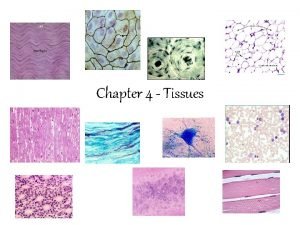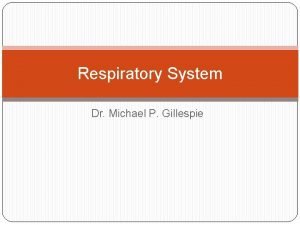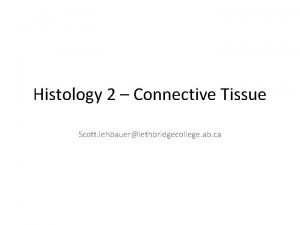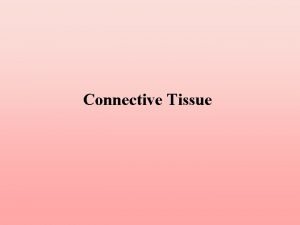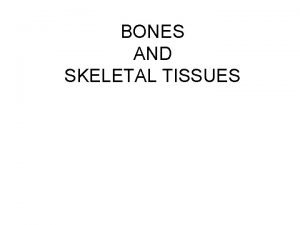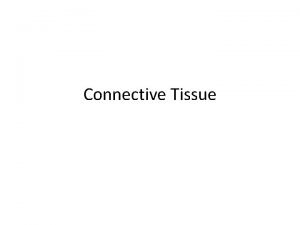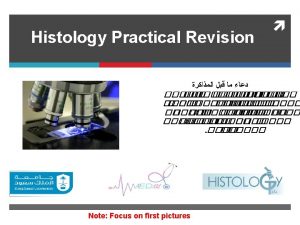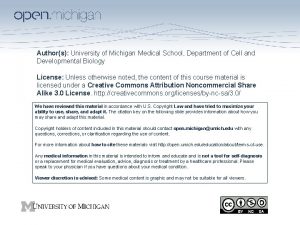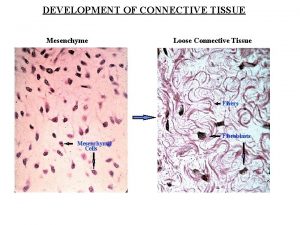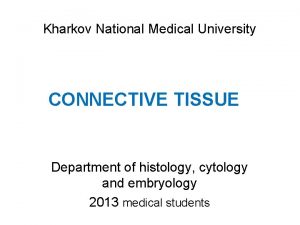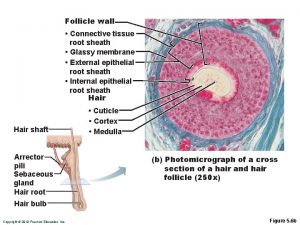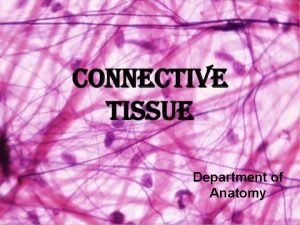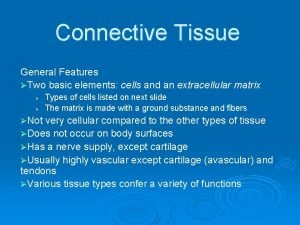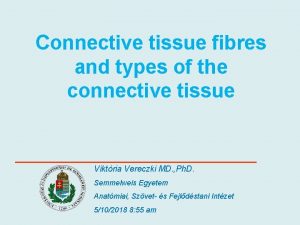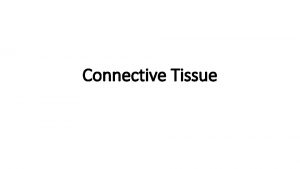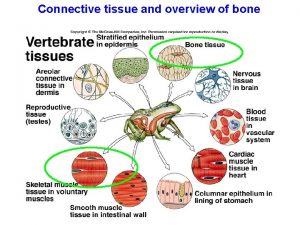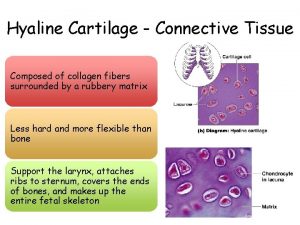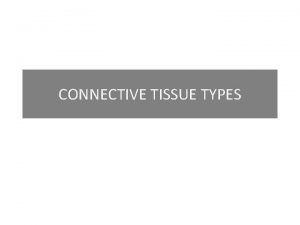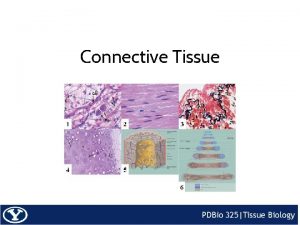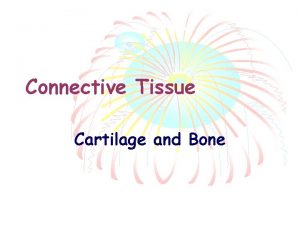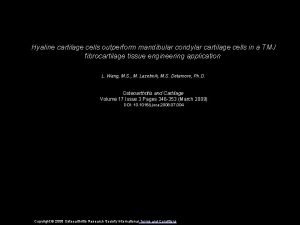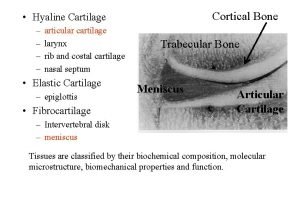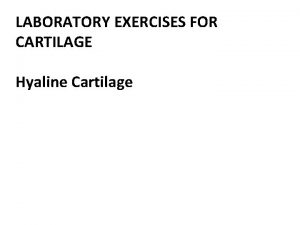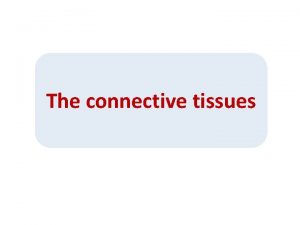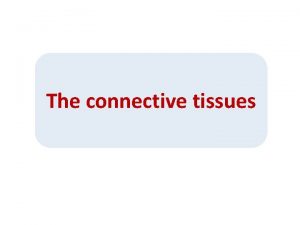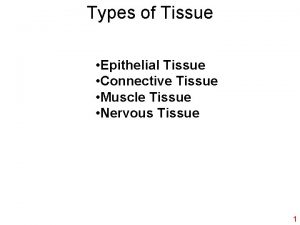Connective Tissue Cartilage Three types of cartilage Hyaline






















- Slides: 22

Connective Tissue: Cartilage • Three types of cartilage: – Hyaline cartilage – Elastic cartilage – Fibrocartilage

(g) Cartilage: hyaline Description: Amorphous but firm matrix; collagen fibers form an imperceptible network; chondroblasts produce the matrix and when mature (chondrocytes) lie in lacunae. Function: Supports and reinforces; has resilient cushioning properties; resists compressive stress. Location: Forms most of the embryonic skeleton; covers the ends of long bones in joint cavities; forms costal cartilages of the ribs; cartilages of the nose, trachea, and larynx. Chondrocyte in lacuna Matrix Costal cartilages Photomicrograph: Hyaline cartilage from the trachea (750 x). Figure 4. 8 g

(h) Cartilage: elastic Description: Similar to hyaline cartilage, but more elastic fibers in matrix. Function: Maintains the shape of a structure while allowing great flexibility. Chondrocyte in lacuna Location: Supports the external ear (pinna); epiglottis. Matrix Photomicrograph: Elastic cartilage from the human ear pinna; forms the flexible skeleton of the ear (800 x). Figure 4. 8 h

(i) Cartilage: fibrocartilage Description: Matrix similar to but less firm than that in hyaline cartilage; thick collagen fibers predominate. Function: Tensile strength with the ability to absorb compressive shock. Location: Intervertebral discs; pubic symphysis; discs of knee joint. Chondrocytes in lacunae Intervertebral discs Collagen fiber Photomicrograph: Fibrocartilage of an intervertebral disc (125 x). Special staining produced the blue color seen. Figure 4. 8 i

(j) Others: bone (osseous tissue) Description: Hard, calcified matrix containing many collagen fibers; osteocytes lie in lacunae. Very well vascularized. Function: Bone supports and protects (by enclosing); provides levers for the muscles to act on; stores calcium and other minerals and fat; marrow inside bones is the site for blood cell formation (hematopoiesis). Location: Bones Central canal Lacunae Lamella Photomicrograph: Cross-sectional view of bone (125 x). Figure 4. 8 j

(k) Others: blood Description: Red and white blood cells in a fluid matrix (plasma). Plasma Function: Transport of respiratory gases, nutrients, wastes, and other substances. Location: Contained within blood vessels. Neutrophil Red blood cells Lymphocyte Photomicrograph: Smear of human blood (1860 x); two white blood cells (neutrophil in upper left and lymphocyte in lower right) are seen surrounded by red blood cells. Figure 4. 8 k

Nervous tissue Description: Neurons are branching cells; cell processes that may be quite long extend from the nucleus-containing cell body; also contributing to nervous tissue are nonirritable supporting cells (not illustrated). Nuclei of supporting cells Neuron processes Cell body Axon Dendrites Cell body of a neuron Function: Transmit electrical signals from sensory receptors and to effectors (muscles and glands) which control their activity. Location: Brain, spinal cord, and nerves. Neuron processes Photomicrograph: Neurons (350 x) Figure 4. 9

Muscle Tissue · Muscle cells are called muscle fibers · Are contractile through sliding filament theory · Three types · Skeletal muscle · Cardiac muscle · Smooth muscle

(a) Skeletal muscle Description: Long, cylindrical, multinucleate cells; obvious striations. Striations Function: Voluntary movement; locomotion; manipulation of the environment; facial expression; voluntary control. Nuclei Location: In skeletal muscles attached to bones or occasionally to skin. Part of muscle fiber (cell) Photomicrograph: Skeletal muscle (approx. 460 x). Notice the obvious banding pattern and the fact that these large cells are multinucleate. Figure 4. 10 a

(b) Cardiac muscle Description: Branching, striated, generally uninucleate cells that interdigitate at specialized junctions (intercalated discs). Striations Intercalated discs Function: As it contracts, it propels blood into the circulation; involuntary control. Location: The walls of the heart. Nucleus Photomicrograph: Cardiac muscle (500 X); notice the striations, branching of cells, and the intercalated discs. Figure 4. 10 b

(c) Smooth muscle Description: Spindle-shaped cells with central nuclei; no striations; cells arranged closely to form sheets. Function: Propels substances or objects (foodstuffs, urine, a baby) along internal passageways; involuntary control. Location: Mostly in the walls of hollow organs. Smooth muscle cell Nuclei Photomicrograph: Sheet of smooth muscle (200 x). Figure 4. 10 c

Connective Tissue Types · Adipose tissue · Many cells contain large lipid deposits · Functions · Insulates the body · Protects some organs · Serves as a site of fuel storage

Epithelial Membranes • Cutaneous membrane • Mucus membranes • Serous Membranes

Cutaneous membrane (skin) (a) Cutaneous membrane (the skin) covers the body surface. Figure 4. 11 a

Mucosa of nasal cavity Mucosa of mouth Esophagus lining Mucosa of lung bronchi (b) Mucous membranes line body cavities open to the exterior. Figure 4. 11 b

Parietal peritoneum Parietal pleura Visceral peritoneum Parietal pericardium Visceral pericardium (c) Serous membranes line body cavities closed to the exterior. Figure 4. 11 c

Scab Epidermis Blood clot in incised wound Inflammatory chemicals Vein Migrating white blood cell Artery 1 Inflammation sets the stage: • Severed blood vessels bleed and inflammatory chemicals are released. • Local blood vessels become more permeable, allowing white blood cells, fluid, clotting proteins and other plasma proteins to seep into the injured area. • Clotting occurs; surface dries and forms a scab. Figure 4. 12, step 1

Regenerating epithelium Area of granulation tissue ingrowth Fibroblast Macrophage 2 Organization restores the blood supply: • The clot is replaced by granulation tissue, which restores the vascular supply. • Fibroblasts produce collagen fibers that bridge the gap. • Macrophages phagocytize cell debris. • Surface epithelial cells multiply and migrate over the granulation tissue. Figure 4. 12, step 2

Regenerated epithelium Fibrosed area 3 Regeneration and fibrosis effect permanent repair: • The fibrosed area matures and contracts; the epithelium thickens. • A fully regenerated epithelium with an underlying area of scar tissue results. Figure 4. 12, step 3

Developmental Aspects • Primary germ layers: ectoderm, mesoderm, and endoderm – Formed early in embryonic development – Specialize to form the four primary tissues • Nerve tissue arises from ectoderm • Muscle and connective tissues arise from mesoderm • Epithelial tissues arise from all three germ layers

16 -day-old embryo (dorsal surface view) Ectoderm Mesoderm Endoderm Epithelium Muscle and connective tissue (mostly from mesoderm) Nervous tissue (from ectoderm) Figure 4. 13

Clinical Application Collagen Disorders Chondrodysplasia • collagen chains too wide • stunted growth • deformed joints Hereditary osteoarthritis • change in amino acid in collagen • painful joints Look up Osteogenisis imperfecta Dystrophic epidermolysis bullosa • breakdown of collagen that attaches skin layers • stretchy skin • lax joints
 Nucleus
Nucleus Connective tissue biology
Connective tissue biology Dense connective tissue description
Dense connective tissue description Gas change
Gas change Hyaline cartilage functions
Hyaline cartilage functions Four basic tissues
Four basic tissues Wolffs law
Wolffs law Howship lacunae
Howship lacunae Regulation of breathing
Regulation of breathing Hyaline cartilage cells
Hyaline cartilage cells Microscopic structure of hyaline cartilage
Microscopic structure of hyaline cartilage Costal cartilage
Costal cartilage Hyaline cartilage vertebrae
Hyaline cartilage vertebrae Cartilage hyaline
Cartilage hyaline Connective tissue fiber
Connective tissue fiber Connective tissue bone
Connective tissue bone Description of nerve tissue
Description of nerve tissue Fibrocytes
Fibrocytes Hair follicle glassy membrane
Hair follicle glassy membrane Dense irregular connective tissue
Dense irregular connective tissue Type of tissue
Type of tissue Areolar tissue
Areolar tissue Classification of connective tissue
Classification of connective tissue

